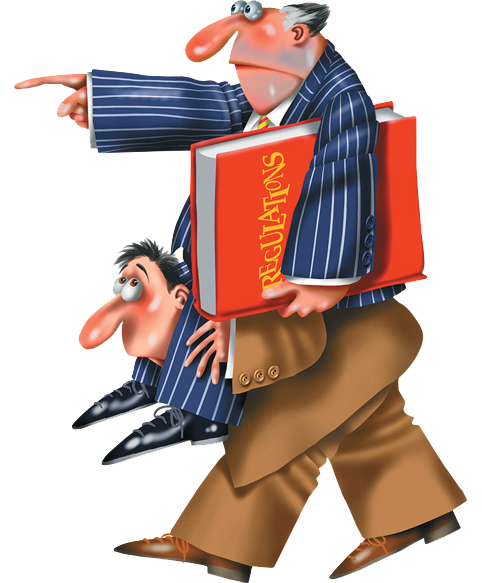|
exhibiting 101

ILLUSTRATION: Eldon Doty
How to Break the Rules
When it comes to violating trade show guidelines, it's better to ask permission rather than forgiveness.
When I received my first exhibitor
services manual, I thought the rules in it were written in stone. My boss told me they were – and he stressed that the way to stay out of trouble was to follow all show rules to the letter. But as I attended show after show, I watched as other exhibitors didn't implicitly follow the rules, and I began asking, "How are you getting away with that?" While a handful gave me a deer-in-the-headlights look that seemed to imply they didn't realize rules existed, most told me about a little thing called a variance. Simply put, a variance is permission from show management to break one or more of its rules. And while blatantly breaking a rule at a trade show can get you into big trouble, asking permission to break said rule never hurt anyone.
But where do you start? Who do you contact to get that permission? What kinds of forms should you fill out, and to whom do you need to return the paperwork? Is there a timeline that should be followed? What types of variances can be requested? As you can see, asking to break a rule brings up a slew of additional questions. Fortunately, I have the answers to all of them, and am sharing that information here with you. First, read all of the exhibiting materials that regulate the trade show. These can include the terms and conditions (aka "Ts and Cs") included in your booth space rental agreement, The International Association of Exhibitions and Events (IAEE) Guidelines for Display Rules and Regulations, and the exhibitor services manual that typically includes directives from the show organizer, show manager, venue, and official contractors and subcontractors. Second, mark any sections that seem contrary to your exhibiting goals, won't work with your existing exhibit properties, or just plain don't make sense. Next, figure out the changes to those rules that would make your exhibiting experience more productive. For example, perhaps your exhibit property has a 12-foot-tall back wall, but the show rules state only 8-foot-tall walls can be used. With the problem rules marked and possible solutions identified, contact show management at least 60 to 90 days prior to the start of the event. This gives the show manager time to think through your variance request, consider who it will affect, and contact the parties involved (which can include exhibitors in neighboring booth spaces, the facility manager, local fire officials, and labor unions). In many cases, simply reaching out to show management directly is an acceptable way to request a variance, but be sure to ask if there is a particular variance-request form that needs to be completed. Finally, put together your case for the variance, providing a logical explanation of why the change is being requested. Include things such as how it will enhance the attendee experience, whether it will lessen your costs, and what impact, if any, it will have on other exhibitors. Compile materials that support your request, such as photos, renderings, samples, and marked floor plans. Keep in mind that while you can request a variance for any rule and from anyone making rules at the show, the less affect your variance has on neighboring exhibitors and the show in general, the higher likelihood it has of getting the go-ahead. Here are some of the most commonly granted variances with tips on how to secure them. 1. Terms and Conditions. As excruciating as it is to read all of the fine print on the back of your booth space application and contract, you have to do it. "Ts and Cs" dictate everything from space-deposit payment schedules and show-services discount deadlines to the amount of time allowed to review show-related contracts. I've signed up late for shows (as in, past the discount deadline) and asked show management to add a clause into the "Ts and Cs" that effectively allowed me to still take advantage of the discounts. I've also asked for two additional weeks after I signed a booth space contract to allow my company's legal and procurement departments time to review it and raise any concerns with show management. If you have a legal department, it's simply good business sense to have it review the booth space contract and submit requested changes before it's signed. 2. Deposit Payments. Sometimes the payment schedule outlined by the booth-space contract doesn't coincide with your fiscal year or cash flow, and in these cases, you can request a different payment schedule. Be sure to work with your accounting department to get the payments made on time, because if you miss the agreed-upon dates, you may lose your space.  TIME TO ASK TIME TO ASKThe earlier you ask for permission to break a rule, the better your chances of it being granted. Here's what you should do in the months leading up to a show. 90 to 120 Days: Read the exhibitor kit. 60 to 90 Days: Submit variance request(s). 30 to 60 Days: Get written confirmation of granted variance(s). 3. Deadlines. When you sign up late for a show, are close to the discount deadline for show services, and/or are past the due date for exhibitor appointed contractor (EAC) services, make it a stipulation in your booth-space contract that you be given a week or two extension. This will give you time to submit all the necessary paperwork and still receive the early bird discounts and available service options. 4. Cubic Content. If you're not familiar with the term "cubic content," it is a unit of measurement allowing display materials and products to occupy 100 percent of the exhibit space purchased, regardless of sightlines, up to a height established by the exhibition's rules. In 2014, the IAEE Guidelines for Display Rules and Regulations added information on exhibitor use of full cubic content within a booth space, rather than limiting space use based on the usual line-of-sight regulations. Some variance requests are based on exhibitors wishing to forego setback restrictions such as line-of-sight rules, using cubic content rather than having low side walls in the front half of their booth space. 5. Exhibit Height. According to the IAEE, standard exhibit heights are 8 feet for an in-line (linear) exhibit, 12 feet for perimeter exhibits, and 16 or more feet for peninsula and island exhibits. These heights may be either accepted or changed by individual show managers based on the ceiling height in the convention venue. So, if you have an exhibit property that has a 16-foot back wall and a perimeter booth space that would usually be restricted to 12 feet, you are within your rights to ask show management to grant a variance allowing you to use your taller back wall. 6. Hanging Signs. IAEE guidelines state that hanging signs are not permitted above linear and perimeter exhibits, and that ceiling height dictates the maximum sign height over peninsula and island exhibits. But I've been allowed to hang a banner over a linear, perimeter exhibit when I was located at the end of an aisle in a corner, because it didn't infringe on anyone else's space. On the flip side, show management once vetoed a hanging sign over my island exhibit because the space was under a curved ceiling in the back of the hall at Moscone Center. Fortunately, the issue was resolved by ensuring that neighboring exhibitors didn't mind if the sign hung slightly outside the cubic space of my booth. 7. Lighting. If your exhibit has a lot of specialized lighting, monitors that are light sensitive, or a theater in which presentations will take place, you might want to restrict the venue's ceiling lighting. Ask the facility's electrical contractor if it can temporarily remove the hall lighting directly above your exhibit. Keep in mind that you'll have to pay for both labor and equipment to remove and then replace the bulbs. 8. Advance Warehouse Storage. You will typically get 30 days of free storage at a trade show's advance warehouse, but can sometimes ask for more (for a very small fee or at no charge). This is particularly helpful when you have a lull in your show schedule and need a few extra days of storage between events. 9. Inbound Target Date/Time. When your show freight is coming directly from another trade show, you may be able to get a variance from an assigned target date and time without incurring the usual financial penalty for missing a deadline. Start this negotiation with show management, which will then work with the GSC's freight department to adjust the target date to accommodate your shipping and installation-and-dismantle schedule as needed. If you are bringing in multiple shipments to a trade show, such as exhibit properties on one truck and product and equipment on another, you can also work with the GSC's freight supervisor to stagger your inbound target dates and times to avoid filling up aisle space on crowded show floors, which can benefit both your neighboring exhibitors and the forklift drivers. 10. Blended-Rate Drayage. You can request a blended material handling (aka drayage) rate if you are shipping items such as marketing collateral and promotional products that will be distributed at the trade show and not handled again as outbound freight after the event. Your best chance at being granted this variance is if the materials in question are coming in on a separate bill of lading and can be segmented from the rest of your shipment for billing purposes. This is because the weight is then recorded on a separate certified weight slip. 11. Special-Handling Drayage Fees. Depending on how your exhibit freight is loaded, you may be able to negotiate away the special-handling drayage fees that most GSCs charge for unloading any type of vehicle other than common-carrier loads. Many van-line shipments of crates and pallets are floor loaded (not stacked) and removed through the rear trailer doors, which means no additional labor or equipment should be required to unload. 12. Show Hours. It's possible to host press briefings, receptions, and meetings in your exhibit outside of regular show hours, but note that you may have to pay for additional security and have your guests escorted from the hall entrance to your booth.  Whatever variances you end up requesting, make sure you get approval from show
management in writing. Whatever variances you end up requesting, make sure you get approval from show
management in writing.13. Expedited Outbound Loading. If you're leaving directly from a show to get to another show on a tight deadline, you can work with show management and the GSC to segregate your crates in a separate area where you'll get them back sooner than other exhibitors, thus expediting your exit. The GSC and show management will also give you preferential treatment when it comes to loading your freight onto your truck after the trade show. 14. Setup Hours. Some shows restrict the number of setup and teardown hours. If these restrictions cause scheduling problems with your I&D labor, ask show management to allow additional hours after the floor is closed. It might require that you provide venue security guards with a list of staff working in the exhibit after hours, or supply stickers for your after-hours staff to wear. 15. Fire Regulations. If you have issues with the regulations spelled out by the local fire marshal at a show, contact him or her to discuss your options. These variances typically have to do with the placement of fire apparatus within your booth space. For example, I was allowed to relocate a fire extinguisher by a few feet onto a nearby exhibit wall as long as I supplied identifying signage that met the fire marshal's specifications. I've also hired additional fire-watch personnel to limit access to a second deck hospitality suite when the stairway didn't meet width requirements. 16. Billing. Paying your invoice while on the show floor is negotiable. Depending on whether you're a national account with the official GSC or a government affiliate – or you simply pay your bills on time – you might be able to set up accounts with your on-site vendors that will then bill you after the show. You can typically arrange to get billed up to 30 days afterward, though suppliers will require that a valid credit card is on file until the bill is paid in full. Get it in Writing Whatever variances you end up requesting, make sure you get approval from show management in writing. Keep copies of this paperwork with you on show site in case someone questions your variance. And if your request is denied, it's important to ask why. Perhaps you can work with show management to come up with a compromise. If not, chalk it up as a learning experience and move on to a plan B. Just remember – if you don't ask, you have no chance of changing the rules. So don't be shy. The worst they can tell you is "No." E  Candy Adams
Candy AdamsCTSM, CEM, CMP, CMM "The Booth Mom," is an independent exhibit project manager, trainer, speaker, consultant, and an Exhibitor Conference faculty member. CandyAdams@BoothMom.com
|
|
|
||||||||||||||||||||||||||||
|
|
||||||||||||||||||||||||||||
|
TOPICS Measurement & Budgeting Planning & Execution Marketing & Promotion Events & Venues Personal & Career Exhibits & Experiences International Exhibiting Resources for Rookies Research & Resources |
MAGAZINE Subscribe Today! Renew Subscription Update Address Digital Downloads Newsletters Advertise |
FIND IT Exhibit & Display Producers Products & Services All Companies Get Listed |
EXHIBITORLIVE Sessions Certification Exhibit Hall Exhibit at the Show Registration |
ETRAK Sessions Certification F.A.Q. Registration |
EDUCATION WEEK Overview Sessions Hotel Registration |
CERTIFICATION The Program Steps to Certification Faculty and Staff Enroll in CTSM Submit Quiz Answers My CTSM |
AWARDS Sizzle Awards Exhibit Design Awards Portable/Modular Awards Corporate Event Awards Centers of Excellence |
NEWS Associations/Press Awards Company News International New Products People Shows & Events Venues & Destinations EXHIBITOR News |
||||||||||||||||||||
|
||||||||||||||||||||||||||||






